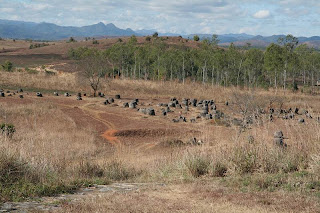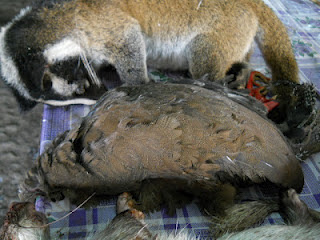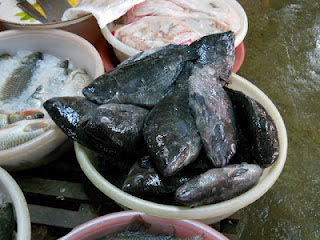 Xieng Khouang Province is a land of Laotian as well as the American heroes who both fought in the Secret War which also involves Thailand and North Vietnam.
Xieng Khouang Province is a land of Laotian as well as the American heroes who both fought in the Secret War which also involves Thailand and North Vietnam.Udon Thani in Thailand was the American headquarters airbase where Pan Am 707 planes and C47 transport planes supported in the covert operations in Laos.
It was in 1961 when the Vietnam War started and the Pathet Lao, the communist Laos party has allied with North Vietnam while the Royal Laotian party which was the ruling government, allied with Thailand and the United States. In order to stop the spread of communism(communist Soviet bloc also in the shadow),Laos must not be overtaken so as to prevent a domino effect which will spill into Thailand and the rest of Southeast Asian countries.
Hence these three countries formed an alliance to counteract the communist aggressor which is thereby known as the Secret War.
The American CIA most vital backup in the war against communism was Vang Pao, a leader among Hmong hill tribesmen.
The hostility between the communists of Laos and the Hmong minority was not only due to the Marxist enmity toward traditional cultures (and religion).
The Hmongs, long ago driven out of China, had been on the side of the French in the anti-colonial revolution.
American intelligence agents who remained in Thailand after the defeat of Japan helped organize the Hmong and other ethnic minorities in an alliance with the Royal Lao Army against the Pathet Lao, counterpart of the Viet Cong.
The Secret War ended in the same year as the Vietnam War—1975 and subsequently the Pathet Lao communist party also took over Laos and the Hmongs that were left behind were seen as a threat and persecuted.
Thousands of Hmong people left Laos in 1975, at the end of what some historians have begun calling The Second Indochina War, taking refuge in sordid camps along the Thai border.
Slowly, Congress allowed some of the refugees to immigrate to the U.S.
Most settled in California, Wisconsin and Minnesota.
The Census estimates about 250,000 Hmongs and their descendants live in the U.S.
But few Americans even know their name. Vang Pao died at age 81.
In early February 2011 the Associated Press brought worldwide attention to his six-day funeral in Fresno, California. His body lay in the Fresno convention center, where CIA veterans paid their respects amid Hmong ceremonies for a hero.

The plain of Jars is situated about 12 Km from Phonsavan.
There are over 300 stone jars scattered across the plateau.
The size of the jars is varied from 1 to 3 meters high and up to 2.7 meters in diameters and the heaviest one is weighing 6 tons.
Information centre and village Ban Phai:
Ban Phai is a mix of lowland Lao, Hmong and Khmu families and has a high degree of traditional houses. The villagers are subsistence farmers and women weave or embroider in their free time.
Visit the information centre to learn more about this typical rural village and be information about the nearby granite jar site; have a relax drink on the hill side whilst admiring the stunning landscape.
Jar site at Phai village: this small jar sites consists of 36 granite jar and oppose the sandstone jars found at most site. It is easily accessible and within walking distance from the information centre.
Pha Keo village:this remote Hmong village, located on the upper slopes of the mountains, is only accessible by walking. The small farming community with 20 households has retained a high degree of traditional customs and living.
Stay at the community lodge, taste local cooked food prepared by villagers and enjoy the interaction with villagers.
ThaLin Village: Ban ThaLin village is a traditional Hmong village located at the end of the road in a valley in the mountains and starting point of the trek. The scattered houses of the village are surrounded by farm fields.
Jar site of PhaKeo village:on the mountain ridge near the village of Phakeo are several jar sites; the biggest group counts nearly 400 sandstone jars and is the most impressive recorded jar site so far. Located in a lush forest with wild orchids growing on jars, this site contains stone lids and grave markers with animal bas reliefs.
 Tad Kha waterfall:the waterfall is very great place to relax, have a picnic and enjoy Loa’s natural beauty.
Tad Kha waterfall:the waterfall is very great place to relax, have a picnic and enjoy Loa’s natural beauty.The community manages the place to keep it clean, maintains the trail and protects the forest.
Tajok village:this Hmong, village is very good example of how war remains are integrated into daily lives. Take a walk to the village and discover bomb fences and herbs growing in bomb casings.
Old Capital(about 30km southeast): Muang Khoun is the former capital of the Phuan kingdom and was the provincial administrative centre during French Indochina.
This rural centre of faded glory was heavily bombed at the end of the 1960’s and bears testimony to centuries of aggression. Traditional Tai Dam village basket and textile weaving can be seen at Nasi and you can buy directly from the handicraft maker.
Cemeteries: a small Vietnamese style stupa and cemetery on the way to the village of Ban Phai show the close relationship of Xiengkhouang in particular the old capital with Vietnam.
Other places of interest in Xieng Khouang.
War Memorials:
South of Phonsavan are two war memorials set 1 km apart from each others. One is Lao war memorial and the other is Vietnamese war memorial.
Muang Kham Cemetery:
Unique and worth a visit just for the unusual site of mixing together Thai Dam animist tombs, Catholic headstones and Laos (Buddhist) tombs, situated east of Phonosavan.
That Foun (Old Xieng Khouang - Muang Khoun)(5):
This Buddhist stupa is also known as That Chomsi. It measures about 30 meters and was built in 1576.
Muang Sui:
Ex-Americans landing site for planes during the Indochina War.
Tham Pa Caves(6): These two limestone caves contained hundreds of small Buddha figures, believed hidden from the Haw invasion a few centuries ago.
Xieng Khouang Province is being administered by a provincial governor.
Entrance to Wat Santiphat on a hilltop.
Young monks of Wat Santiphat,from left Siphon,Duangdee and Tavon.
An English speaking monk Pratsomchai attended the evening language class at Asa Phattana College.
Surprisngly he comes from Thailand.
This side of building facing main Route 7, presumly must be the back entrance as another side road is the main entrance with gate to the four storey building.
Phonsavan's busy large market behind the post office.
It closes around 8:00 pm at night.
Fresh water fish 'tilapia'
Laotian Chinese girl doing cross-stitch embroidery. You can try the barbeque banana for 1,000kips.
Wild boar for sale.

Wildlife on the table already dead.
Must be the palm civet (musang).

Porcupines.
Fried noodles for 10,000 kips as breakfast in the market.
Sticky rice bamboo containers (Tip Khao).
Multi layered roof architecture building being a local government official residence.
Young Lao boy just back from school.












No comments:
Post a Comment